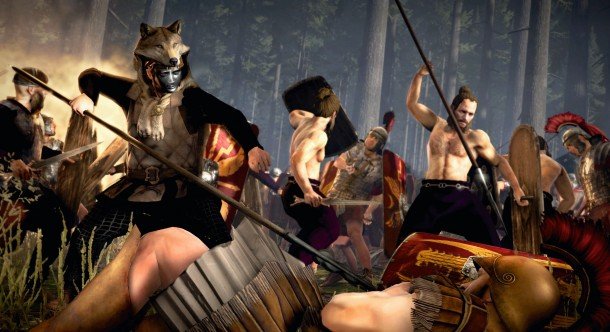Total War: Rome 2 preview - ambush and betrayal in the ancient world RTS

In the early autumn of 9 CE a Roman general named Publius Quinctilius Varus led an expedition deep into the German interior. He was investigating reports of unrest among the local tribes, and marched despite warnings that one of his advisors – a German named Arminius – planned to betray him. Arminius had been raised by the Romans, and Varus trusted him.
History has not been kind to the general, in light of what happened next.
"Teutoburg will be a historical battle in the final game – a standalone challenge with distinct rules."
He got it spectacularly wrong. Arminius was planning to betray him: working in secret with the German tribes he had set a trap for the Roman commander deep in the Teutoburg forest. The problem for the Roman Empire was that Varus wasn't marching into this trap by himself. More than fifteen thousand men were marching with him.
This isn't just the story of how a few bad decisions can lead to military catastrophe: this is the story of how it's possible to lose three full legions of the most renowned fighting force of its age. This is the story of how it's possible to beat the Romans.
I'm watching Rome II's take on the battle of the Teutoburg forest being played by Creative Assembly communications manager Al Bickham. Like the battle of Carthage sequence, Teutoburg will be a historical battle in the final game – a standalone challenge with certain distinct rules. Unlike the pre-scripted Carthage demo, however, the battle of Teutoburg is being played live – tactical blunders and all.

I immediately get a clearer sense of how Rome II's cinematic aspirations will be realised. The mission begins with a framing vignette: the corpses of dozens of Roman soldiers lie on the leaf-scattered floor of a misty forest rendered in cool blues and greys. The voice of the Emperor Augustus screams the words attributed to him in the aftermath of the disaster – “Quinctilius Varus, give me back my legions!”
"As the attack begins, flaming balls of pitch tumble from the treeline and crash into the unready Romans."
Cut to three weeks earlier.
Keep up to date with the most important stories and the best deals, as picked by the PC Gamer team.
The Romans are marching in a line through the forest, hemmed in on both sides by tall embankments, their vision obscured by trees. Elsewhere, Arminius addresses his own troops, renouncing his upbringing and vowing to lay waste to the imperial invaders. As the attack begins, flaming balls of pitch tumble from the treeline and crash into the unready Romans, their screams of surprise drowned out by the roar of Germanic warriors emerging from the woods. At the moment of impact – as Varus wheels around in response to the chaos – control is handed over to the player.
Rome II alters the traditional Total War interface in a number of ways. The unit cards along the bottom of the screen are now larger and heavily stylised, the designs varying from culture to culture. Mediterranean factions are represented by pictograms inspired by Greco-Roman pottery: angular figures rendered in black and red against a clean white marble background.
These cards can be minimised and will shrink as armies grow. The idea, as explained to me by lead battle designer Jamie Ferguson, is that as the player's level of knowledge rises they'll become more familiar with their units and therefore won't need as much information on the fly as they did when they started out.

The traditional UI elements are present but there's been an evident effort to reduce clutter and communicate more information within the battle simulation itself. Men respond to their environment as individuals – whether by glancing at a new enemy that has appeared from the forest, or dynamically raising their shields to protect themselves from incoming fire. Barks and other incidental voiceover elements are much more pronounced than in Shogun 2. I hear a Roman captain shouting at his men to abandon the wounded as the legionaries attempt to break free of the ambush. In one instance, the writing is missionspecific. “Where is Arminius?” Varus yells, panicked, in a moment of irony. “We need his auxiliaries!”
"The game can be controlled without having to take your eye off what your men are doing."
The notion is that the game can be controlled without having to take your eye off what your men are doing to look at a number ticking down on a unit card. This feeds directly into the more reactive style of play that Rome II promotes – even though the controls, as far as setting formations and giving movement orders go, haven't changed. The objectives of the various battle types are now more varied: while a field skirmish might revolve around control of baggage trains, a siege will have entirely different parameters for success.
The aim is to reduce the sense that each Total War battle is necessarily a straight-on clash between massive armies, to provide more room for surprise, and to make it more interesting to be outnumbered.
“You get a lot more variety in the way that combat falls out,” Jamie Ferguson tells me. “As a defender, you can't be quite so sure of yourself.”
Joining in 2011, Chris made his start with PC Gamer turning beautiful trees into magazines, first as a writer and later as deputy editor. Once PCG's reluctant MMO champion , his discovery of Dota 2 in 2012 led him to much darker, stranger places. In 2015, Chris became the editor of PC Gamer Pro, overseeing our online coverage of competitive gaming and esports. He left in 2017, and can be now found making games and recording the Crate & Crowbar podcast.


